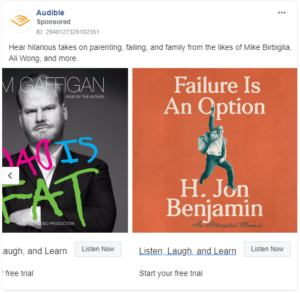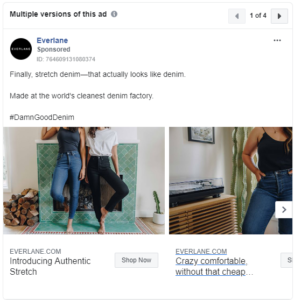When researching carousel Facebook ad examples, I asked my 18-year-old sister if she could monitor her Instagram feed for good case studies. “You know what a carousel ad is, right?” I asked.
“Yeah,” she said, “with the horses and stuff?”
With that response, it’s safe to say that consumers may not know exactly what this type of ad is. But is it effective? I explained the carousel concept to my sister — multiple pictures that you can scroll through within the ad itself.
“Oh,” she said, “That’s what got me to buy my iced coffee koozie!”
So, even if consumers don’t know the name, it can definitely be effective. And not just on my sister. When done right, Facebook carousel ads can be more effective than single-image ads.
If you haven’t already, add this Facebook ad style to your brand’s repertoire. Here’s how to master the form.
NOTE: Since many of these ads run on the integrated Facebook and Instagram platforms, I’ll be covering both.
Facebook carousel ad best practices
Facebook’s Business Help Center lets marketers in on some pretty basic best practices. For example, they recommend using every component of the carousel ad to make it shine. Although it’s an image-heavy form, Facebook marketers remind you to not “ignore snappy headlines, descriptions and calls-to-action that give context, detail and encouragement.”
Facebook also encourages carousel ad creators to stick to their ad guidelines (of course), pair your ad with a specific landing page, and connect with potential customers through “lifestyle imagery.”
Like I said, these are pretty basic best practices, especially for seasoned marketers. The real carousel magic happens with the form’s unique features.
For example, you have the option to show the best-performing images first. You can also add features like your page’s profile image as the last card or a special map card showing your business’ location.
Take advantage of these features and experiment. Carousel ads could prove to be some of your most effective.
Why they work
Consumers stay on the ad longer.
Since there’s more to see, consumers may dwell on these ads longer than single-image ads. This tells Facebook and Instagram algorithms that you’re doing something right. Then, because your ad has won the algorithm’s favor, it shows the ad to more and more users.
On Instagram, users are used to swiping left.
Influencers, brands, and your snap-happy Aunt Becky all take advantage of the gallery posting feature on Instagram. It seems that every other post now has multiple images.
If you’re retargeting, you introduce more options.
Facebook serves retargeting ads to users who have already been on your site. Perhaps they considered one of your products but weren’t convinced. A retargeting carousel ad can reintroduce them to the product they were looking for, plus reveal a wide range of other options.
Facebook ad examples: Carousel ideas to get inspired
Show multiple products
This is probably the most popular type of carousel ad and the one that pops up in your feed most often. The big perk of these ads is getting to feature multiple pictures — and multiple pictures means multiple products.
Java Sok
Let’s start with my sister’s story, since I already told you it got at least one conversion.
The concept here is pretty simple: Show different products in action with some basic photos. But sometimes, simple works, especially when the product itself is simple too.
Try showing different styles of your product in action. If a consumer isn’t thrilled with the first image, they can swipe until they find one that fits their fancy.
Audible
Audible is a classic example of a brand that heavily utilizes carousel ads. This one shows multiple audiobooks available within the comedy category. Consumers interested in comedy get this ad and see how many options Audible has in their genre of choice. Those interested in drama may see a collection of dramatic audiobooks. And those interested in nonfiction may see audiobooks based on true events. I think you get the point.
Experiment with carousels that display multiple products from the same category. You’ll relate more to the consumers you’re targeting.
HBO Max
HBO Max takes a similar approach to Audible by showing a variety of offerings. However, this ad doesn’t necessarily stick to one category. It goes wide to show just how much the service has to offer.
Especially since this service is so new, using a carousel ad to show the myriad of choices users will have makes sense. The CTA at the end is also a nice touch. It makes it easy for impressed consumers to go ahead and take the leap to sign up.
If your business offers a variety of things, a carousel ad like this can display that variety in a cohesive way.
Show different shots of the same product(s)
In contrast to the multiple-product ads, you could use several different pictures to feature the same product or products.
Curology
This Facebook ad example is tiny but mighty. It only has two images, but the composition of the photos and consistency of products shown allows consumers to focus their attention on the offer.
Try this approach with some of your most popular products. Even just two or three different shots can make potential customers take a second look.
Everlane
All three of these photos highlight the same product — Everlane’s stretch denim. But to really pack a punch, Everlane shows this product in different positions and on different bodies. Instead of telling consumers how well their jeans fit and stretch, they show them with a carousel.
Whether you display different uses for the same product, up-close details at different angles, or unique facets, try using a carousel to emphasize one product and why it’s special.
Try multiple videos
Ilovecreatives
Video Facebook ads can sometimes be even more effective than single images or carousels. So why not use a carousel to increase the amount of video you can show? This ad from Ilovecreatives shares two small videos with an eye-catching aesthetic.
Next time you create a video ad, consider doubling it up with a second video in a carousel.
Use continuity
Alienware
When a user scrolls or clicks through this Facebook ad example, the images line up to form one complete picture. Consumers naturally want to complete what seems unfinished, so using continuity can make even the most ad-adverse want to swipe and discover the full picture.
Split longer photos into multiple images or create wide illustrations to separate into smaller squares. You can show more info and pique a user’s curiosity at the same time.
Make subtle changes
Knowable.fyi
This carousel uses the same image twice. However, the text changes. It kind of ends up working like one of those puzzles where you have to spot the difference. Users want to scroll to see if there are even more versions of the first image. As they scroll, the final image gives them more info to prompt a CTA click.
If you only have a few good images to draw from, this tactic could be great for you. Make tiny changes in text or color. Users will do a double-take.
Start using more images!
These Facebook ad examples should give you a headstart on your mission to incorporate carousels into your strategy. Stick to the best practices and test new things to get a feel for this ad form and how it can work with your brand.
Carousel ads reward creativity. Think outside the single-image box.
P.S. Want some more examples? Search for your favorite brands on Facebook Ad Library.




















